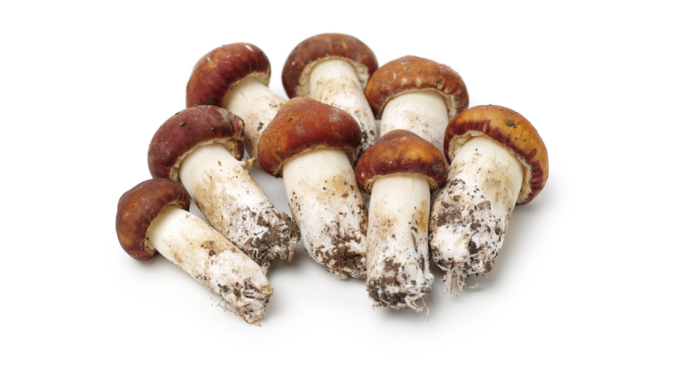Know in one minute about Tricholoma matsutake
|
Introduction
Tricholoma matsutake is also known as matsutake mushroom or pine mushroom belonging to the Tricholomataceae family. It is a naturally occurring edible, rarest, and expensive mushroom due to its attractive appearance and sublime taste. The flavor of this mushroom is aromatic like cinnamon and pine (1). This mushroom has a big white and thick body with a light brown cap and delicate flesh. It is more popular among consumers for its high nutritional and medicinal value. Tricholoma matsutake is available only from forests and forms a symbiotic relationship with pine and oak trees root (2).
Geographical distribution
Tricholoma matsutake is found in East Asian countries including Korea, China, and Japan.
The nutritional value of Tricholoma matsutake
Matsutake is a rich source of protein (20.3%), fiber (29.10%), and carbohydrate (36.67%). It also contains minerals, vitamins, and low fats.
The unsaturated fatty acids like oleic, linoleic, and palmitic acids are higher than saturated ones. Furthermore, polysaccharides, ergosterols, terpenoids, and polyphenols are also present in this mushroom.
These nutrients are not only a high-value food but also boost immunity and suppress the occurrence of many chronic diseases (3).
Health benefits of Tricholoma matsutake
Tricholoma matsutake is not only a nutritional or food flavoring material but also prevents and treats diseases.
Let’s take a look at some of the medicinal properties of Tricholoma matsutake.
1. Treat brain disease
Matsutake mushroom contains matsutakone and matsutoic acid that inhibits the acetylcholinesterase enzyme.
This enzyme causes diseases like Alzheimer’s disease. Thus intake of this mushroom is beneficial to human brain health (4).
2. Treat heart disease
Matsutake mushroom has peptides that relax the blood vessels and decrease blood volume by inhibiting the enzyme that narrows blood vessels. This mushroom treats hypertension and heart failure by lowering blood pressure and decreasing oxygen demand from the heart (5).
3. Prevent skin damage and aging
Matsutake mushrooms contain polyphenols and polysaccharides like beta-glucan. These compounds help to protect the skin against harmful UV radiation.
It also improves skin redness, thickening, coarse wrinkles, and loss of collagen (6). Therefore, ingestion of this mushroom prevents skin aging associated with oxidative stress and inflammation (7).
4. Anti-tumor properties
Matsutake mushroom polysaccharides reduce cancer cell proliferation and migration as well as induce cancer cell death thus treating cancer (8).
5. Antimicrobial properties
Polysaccharides of matsutake mushrooms inhibit the growth of various harmful bacteria. It fights against Micrococcus lysodeikticus, Staphylococcus albus, Brevibacillus laterosporus, Escherichia coli, Bacillus subtilis, and Salmonella sp. thus preventing infections (9).
6. Treat fatigue
Matsutake mushroom contains various bioactive components which are natural antioxidants. These compounds increase the activity of the antioxidant enzyme.
This mushroom improves energy storage and relieves tiredness. It also increases the decomposition of metabolites such as lactic acid and urea nitrogen (10).
7. Boost immunity
Beta-glucan found in matsutake mushrooms activates immune cells. It also promotes the secretion of the molecule that boosts the immune function (11).
The side effect of Tricholoma matsutake
1. Short shelf life
Tricholoma matsutake has a short life ( 1 to 3 days) than other mushrooms like white beech mushroom and oyster mushroom. This is due to the high respiration rate, lack of physical protection to avoid water loss, and microbial attack. Thus, rapid decrease in mushroom quality and marketing period (12).
2. Risk of anaphylaxis or anaphylactoid reaction
Intake of Tricholoma matsutake can cause a severe allergic reaction with symptoms like irritation of the throat, nausea, and hives (urticaria) (13). It also causes skin redness, difficulty in breathing, and swelling on the face, eyelids, and fingers thus precaution should be needed before consumption (14).
3. More expensive than other mushrooms
Matsutake mushroom is quite an expensive mushroom and available only in wild. Thus, it is much less often cooked in homes than other common mushrooms such as Shiitake.
Recipes Tricholoma matsutake mushrooms
Tricholoma matsutake is available in the autumn season in Asian countries. It is very popular among Chinese, Japanese, and Korean dining tables.
This mushroom can easily lose flavor so avoid washing, clean the debris or dirt with a brush or damp paper towel or cloth.
This mushroom can be eaten raw, after baking, boiling, or preserved by freezing and vacuum packing.
There are many ways of cooking mushrooms but keep the preparation simple or not over-worked to retain aroma and flavor.
It can be consumed by slicing, heating, lightly frying, steaming, roasting, or grilling. However, cut the mushrooms into thick slices to maintain flavor and texture.
Tricholoma matsutake is used as a tea, pickle, with rice, ramen, sauces, omelets, pasta, risotto, pizza, and clear broth soup. It is usually sliced thin and grilled with rice wine, dashi, soy sauce, sake, and mirin to makesukiyaki or matsutake gohan.
Q&A
1. Matsutake price?
Matsutake mushroom is one of the most expensive mushrooms and is economically important in Korea, Japan, and China. The cost of this mushroom depends on the quality and place of origin (15). Research studies published in 2009 showed that this mushroom cost is US$ 200 to 600 per kg but its increases with time (16).
